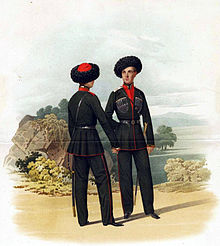

The First Cadet Corps was a military school in Saint Petersburg.
The initiative to create cadet corps for noblemen in Russia belonged to Count Pavel Yaguzhinsky. By the decree of Empress Anna Ioannovna of July 29, 1731, the Senate was ordered to establish a cadet corps. Menshikov Palace on Vasilyevsky Island was transferred to the placement of the school.
The opening took place on February 28, 1732:[3] on this day there were 56 cadets. When in June the number of cadets was already 352, they were divided into three companies. The first graduation took place on June 8, 1734: all 11 graduates were promoted to ensigns.[4]
The first teachers were accepted without any test; since 1736, the best students began to be involved in teaching.[5]
Initially, the corps was conceived for the training of the military, but due to the lack of educational institutions, it began to train civilian officials. This was due to a set of disciplines: simultaneously with the military sciences languages were taught: German, French, Latin, "oratorio" and others. Teachers at school rarely explained the material, reducing learning to memorizing sections. This system changed in 1766, when Ivan Betskoy, who headed the corps, compiled the "Charter of the Land gentry Cadet Corps for the upbringing and training of the noble Russian youth". Instead of dividing the cadets into companies, a division into five ages was introduced. Only children of 5-6 years of age were accepted, whose training was to last 15 years. The youngest age was under female supervision, and starting from the 4th age, pupils shared, "at will or by inclination", to prepare for military or civil services. Each age consisted of five sections. In these departments, both noble children and gymnasium students (children of commoners) studied together. High school students studied on an equal footing with the Cadets. In the corpus, theatrical art, dance, music were studied, while military disciplines were not among the priority ones. As a result, a situation emerged that Semyon Vorontsov estimated as follows:
The officers who left the old cadet corps were only good military men; those brought up by Betskoy, played comedies, wrote poems, they knew, in short, everything except what the officer should have known.[6]
A fundamental change occurred in 1794, when the corps was headed by Mikhail Kutuzov, who reorganized according to the instructions of Emperor Paul I. Instead of five ages, companies were introduced – four musketeers and one grenadier. All civilian teachers were replaced by officers. Tactics and military history classes were introduced, which were conducted not only with pupils, but also with officers.
